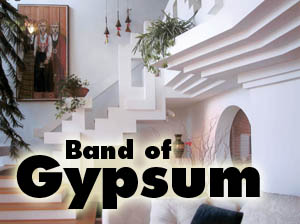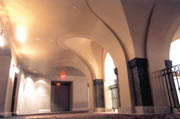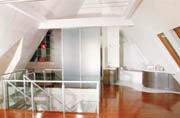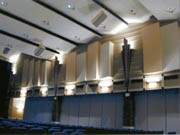

Meeting in January 2003, a panel of gypsum industry professionals and architects chose the winning submittals in the 2002 awards program from entries submitted to the association during 2002.
All entries were judged on project-wide use of gypsum board in innovation, complexity, overall effect and quality of workmanship. One residential and one nonresidential project were chosen as winners. Two honorable mention awards were also given in each category.
Sponsors of both of the winning entries received first place award plaques and a cash prize of $3,000 each. In addition, the entries will be featured in Gypsum Association advertisements announcing the 2003 contest. All of the honorable mention winners received award plaques and incorporation into special Gypsum Association press releases.

And the winners are …
The 2002 residential category winner was a residence, in Great Falls, Va., which was submitted by Verner Svalbe, AIA, of Vienna, Va. Svalbe designed and built the residence, using gypsum board to create a magnificent stair railing system.“The judging panel was awed by both the workmanship involved and the innovative use of gypsum board when they declared this entry the residential category winner,” says Jerry Walker, executive director of the Gypsum Association. “Using gypsum board to create an intricate architectural embellishment, such as a staircase railing system—something that is commonly created from wood or metal—is very innovative. When that was coupled with the extraordinary quality of workmanship achieved and the overall effect created by the staircase, the panel judged this entry to be the winner in the residential category.”
Indeed, the Svalbe submittal is impressive. The high level of workmanship required to make all of the intricate angles and corners line up properly and remain in plane is extraordinary. What appears complicated, however, is actually achieved by the use of a design process that incorporates nothing more sophisticated than 2x6 wood studs and multiple layers of gypsum board.

Made of stone
The nonresidential category winner, the Fairmont Springs Hotel Entry Redevelopment project, in Banff, Alberta, was submitted by TDL Drywall Inc., of Calgary, Alberta. The project was designed by the Leblond Partnership of Calgary.The project involved the relocation of the existing hotel lobby and entrance from the present hotel building to a new side addition. The complex challenge of the project was to match the appearance of the original entry, last renovated in the ’20s, using modern technology and materials. In addition, the hotel could not close during the renovation; hotel staff and guests had to be accommodated with a minimum of disruptions.
“We were impressed by the way gypsum board was used on this project,” says Robert Wessel, associate executive director of the Gypsum Association and a participating member of the judging panel. “Using gypsum board to create arches and ceilings that appear to be made of stone says a considerable amount about the exceptional ability of the craftspeople who installed it and about the versatility of gypsum board and plaster. It is obvious, given the quality of the end product, that the framing and detailing for the project had to be done very carefully. The lobby of this hotel is striking in every detail.”
Honorable mention awards were given to the Nathaniel Center project in Kingwood, Texas, and the West County Mall project in Des Peres, Mo., in the non-residential category. The Granville Towers #74 project, in West Hollywood, Calif., and the Tuscany project, in Confield, Ohio, were awarded honorable mention awards in the residential category. All four projects incorporated impressive workmanship and creative use of gypsum board, often using it as a substitute for a traditional material, such as wood or fabric.
“Identifying the prominent projects to place at the head of the class in each category was a relatively straightforward process for the judging panel,” according to Wessel, “In a contest of this type, exceptional projects generally stand out fairly readily. However, identifying the unambiguous winner from the more prominent entries is not simple. So many of the projects displayed exceptional workmanship, in many instances under difficult finish lighting or working conditions, that it took quite a bit of debate among the four panel members to identify a clear set of award winning entries. Generally, it’s the innovative use of gypsum board that tips the scale toward the winners.”
The awarded projects also show no dependence on size.
“One aspect that I find worthy of note about all of the award winners is the differing overall scale of the projects,” says Walker. “It is interesting that while all three of the residential projects were comparatively small in overall size, two of the non-residential projects were very large. Admittedly, houses and apartments are usually smaller in scale than are non-residential structures; however, it seems that there is no limit on how innovative designers and builders can be when it comes to the use of gypsum board, regardless of the magnitude of the project. Since we want to attract a broad spectrum of entries, our contest intentionally gives both large and small projects equal weight during the judging process. The results seem to validate this approach.”
Additional images of the winners and other entries can be viewed at the Gypsum Association’s Web site at www.gypsum.org.
Plans for the 2003 awards program are complete. Entries must be postmarked by Dec. 31, 2003, to be considered for the program. Entry forms may be obtained by contacting the Gypsum Association or accessing the organization’s Web site.
“We were very pleased with the number of entries received for the 2002 awards program,” says Walker. “I urge all builders and contractors who install or come up with creative ways to use gypsum board to submit an entry for the awards program.”
An early entry bonus will be paid to all complete entries that are submitted by Nov. 14, 2003. Details of the early entry program are included on the awards program entry form.



